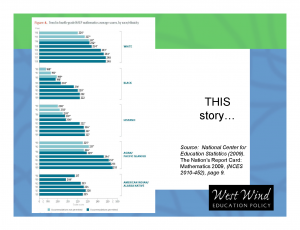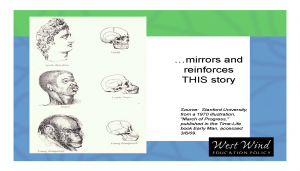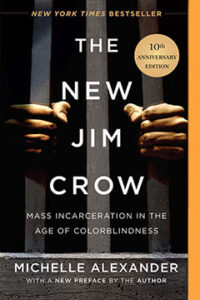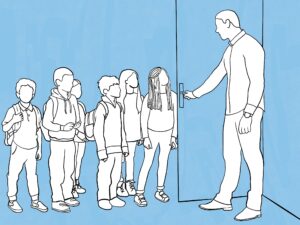Reading Time: 3 minutes“Closing achievement gaps.” It’s a catch phrase that has become the rallying cry for equity advocates; the vision that provides the impetus for many education policies, regulations, and programs.
And it’s a catch phrase we are trying desperately not to use.
In our work, we have found that the phrase re-inscribes negative stereotypes about children of color and their families and sends us down the wrong solution path. That is, the way we talk about a problem does several things:
- It locates the source of the problem, which defines the solutions we consider
- It conveys messages to others about what is happening
- While sometimes it debunks beliefs, it most often reinforces them
For example, if we face a problem of underachieving students, almost universally the solution is to fix the kids (i.e., remediation, supplemental Educational Services, double-dosing, Reading First) or to fix the parents (i.e., parent “involvement”). Toting around chart after chart that graphically display differences in performance between white students and students of color rarely signifies for an audience the deep and historic divides between white people and people of color related to access, equity, and outcomes. Instead, it reinforces deficit thinking about students of color and their families. It reinforces a deep-seated myth that “those” children just are not as smart as white children. When we spoke with the National Assessment Governing Board, we shared with them how their representations of racial achievement mirror a figure that was in a prominent publication when I was entering kindergarten.


As long as we are only focusing on underachieving students, we shift the burden/ blame for low achievement onto students, their parents, and their communities. It takes our focus away from the system and puts it at the feet of children as the source of our problems.
Alternatively, if the problem is defined as underserved students, the solution set is different. Understanding the problem this way, we might look for solutions related to targeting resources (per pupil expenditures, equitable distribution of highly qualified teachers) or improving instruction (using formative assessment, differentiating instruction, implementing research-based practice).
How often have you heard someone decry racial achievement gaps in, say, reading, and then go on to focus solely on reading? Probably the most insidious problem with our hyper-focus on “closing achievement gaps” is that when excellence is defined purely as academic achievement, we can have “excellent” schools that still allow for racial insensitivity that harms children. See Tyrone Howard’s TCR article, Who really cares? The disenfranchisement of African American males in PreK–12 schools: A Critical Race Theory perspective,[1] for examples of such lived experiences of students of color. Or go back and read Ann Arnett Fergusons, Bad Boys: Public Schools in the Making of Black Masculinity. Unfortunately, our hyper-attention to test score data narrows our focus and we ignore aspects of the student experience that matter deeply.
Why do we have widespread acknowledgement of racial achievement gaps but not widespread acknowledgement of race?
We are hopeful that explicit work on race could be what will allow us to crack the historic AND PERSISTENT challenges that most US schools have faced in serving children of color. We have seen that when we define the problem we are trying to solve about schooling today as systemic racism, a whole new solution set is opened up to us. Now we can begin to engage in courageous conversations about race[2] and systemic equity leadership as solutions to the problem of historic and persistent inequities.
We have been deeply moved by educators who are willing to examine their own racial identity and their complicity, even collusion, with white privilege—and the children they encounter as they work in earnest to change. Unfortunately, very few of our education policy discussions get to this framing of the problem. Are you tackling systemic racism in your school, school community, or education policies? If so, we’d love to hear and learn from you!
[1] Howard, T.C. (2008). Who really cares? The disenfranchisement of African American males in PreK–12 schools: A Critical Race Theory perspective. Teachers College Record, 110(5).
[2] Check out our colleagues at Pacific Educational Group for a powerful example of a framework for courageous conversations about race.


 I have easily watched more television since the Olympics began on July 27 than I have since July of last year. It is so easy to just keep watching event after event. The command athletes have over their sports, their bodies, and their minds is evident and addictive to watch and think about. But, the actual competition is only part of the story and only part of what keeps me roped in.
I have easily watched more television since the Olympics began on July 27 than I have since July of last year. It is so easy to just keep watching event after event. The command athletes have over their sports, their bodies, and their minds is evident and addictive to watch and think about. But, the actual competition is only part of the story and only part of what keeps me roped in.  Thank you, Deborah Meier, for being able and willing to reveal your own racism! As Meier tells Diane Ravitch in the
Thank you, Deborah Meier, for being able and willing to reveal your own racism! As Meier tells Diane Ravitch in the 
 Our friends at the FasTrac program are spending their Spring Break on a trip that them from Iowa City, IA to Memphis, TN, Birmingham, Selma, and Montgomery, AL, and Atlanta, GA.
Our friends at the FasTrac program are spending their Spring Break on a trip that them from Iowa City, IA to Memphis, TN, Birmingham, Selma, and Montgomery, AL, and Atlanta, GA.

